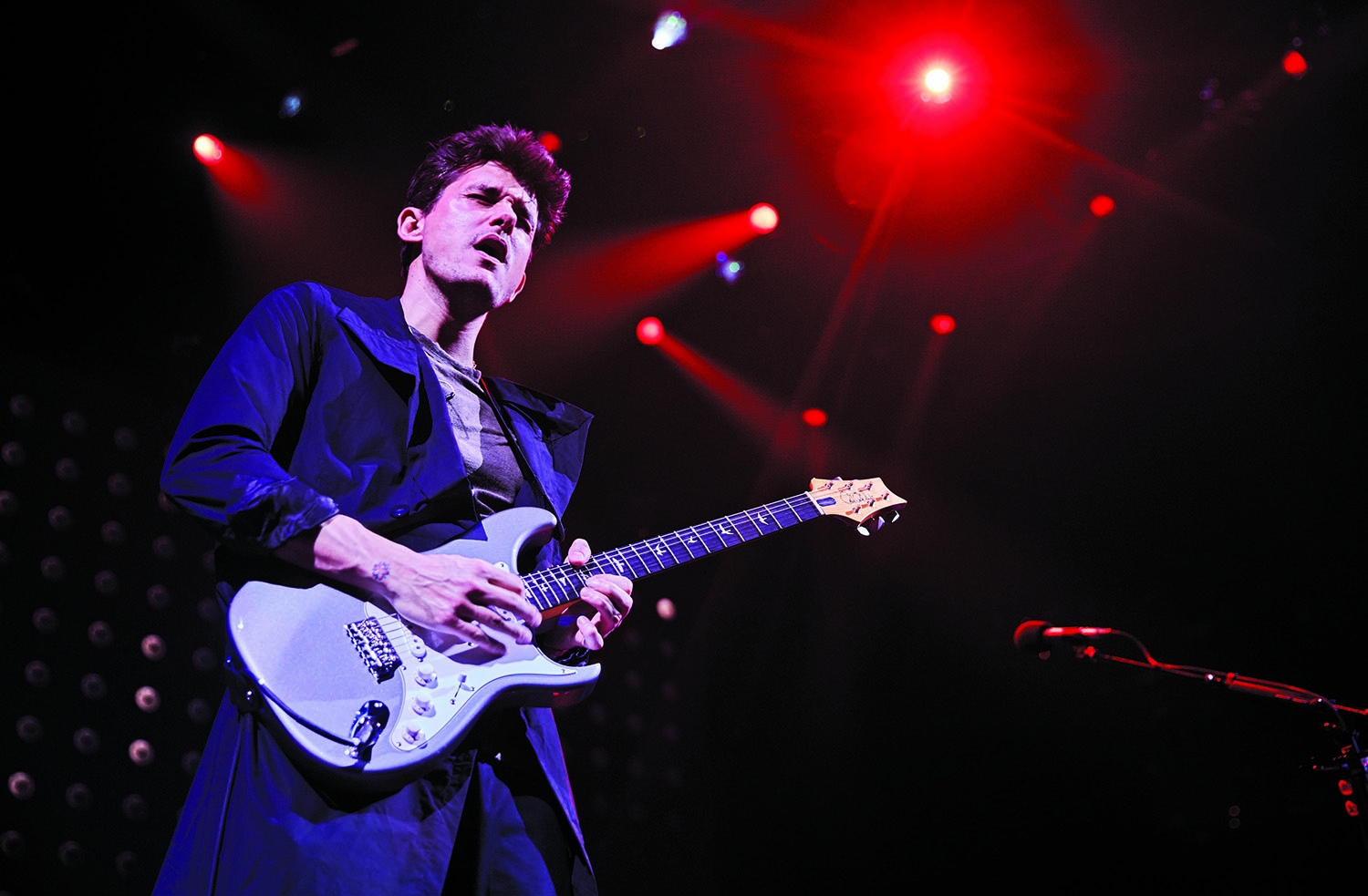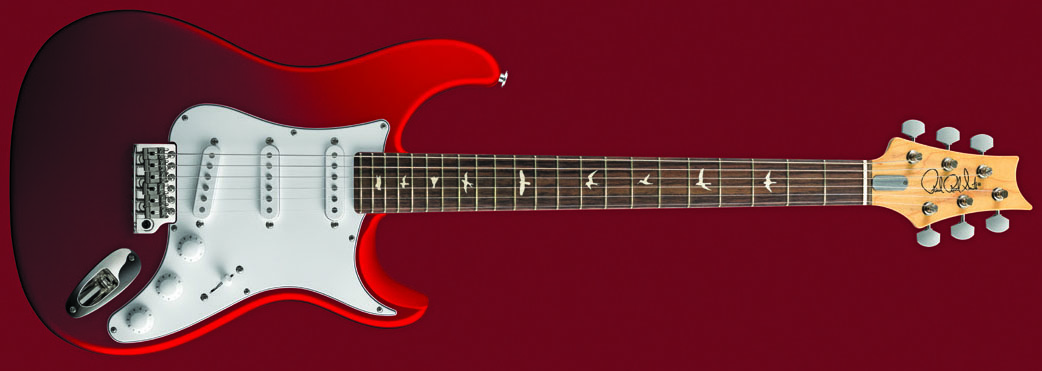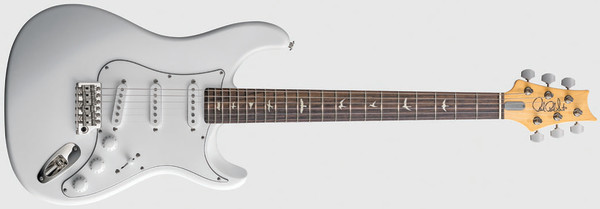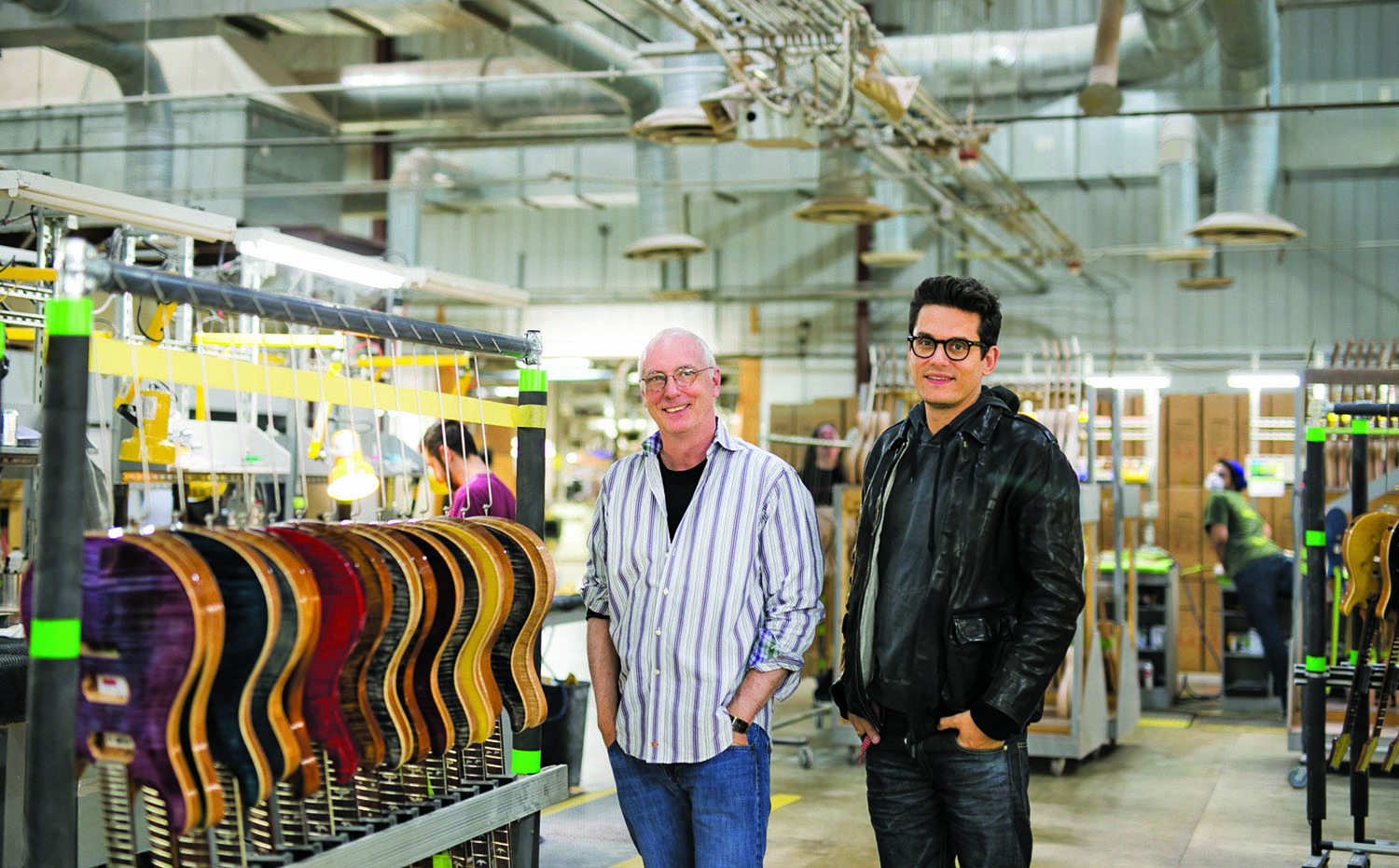John Mayer Explains the Heat Around His Cool New PRS Silver Sky Guitar
"I want to take a point of view and adjust it.” John Mayer opens up about his controversial PRS Silver Sky guitar.

When pop virtuoso John Mayer and master guitar builder Paul Reed Smith unveiled their new PRS Silver Sky in March, the online message boards erupted with the white-hot intensity of Hawaii’s Kilauea volcano. While many guitarists were excited by the six-string creation, others were, eh, shall we say…less enthused.
“Nothing to see here,” groused one irate Tweet, “it’s just a Fender Stratocaster with a PRS neck and headstock.”

“It’s a goddamn betrayal of two great guitar companies,” thundered a host of other Facebook trolls.
And this was before anyone had a chance to play or hear one.

Mayer, who clearly enjoys the role of provocateur, was amused by the ruckus—but not surprised. “Traditionally, the guitar world hasn’t embraced or tolerated evolution all that well,” he says with a dry, knowing laugh. “The initial response to the Silver Sky was pretty negative because people tend to resist anything new. However, being a social media target, I have experience that allows me to really understand the mechanics of disapproval. I’m perfectly tuned to withstand that friction period of people saying they don’t like something.
“Truth is, I don’t think guitarists are really saying they don’t like the Silver Sky. They’re just reacting. I’ve seen the lifespan of people’s negative reactions enough to understand what it means. What most people are really asking is, ‘What is this? What are you trying to do?’ You just need to get through the period that people register their confusion and dissent.
“Of course, there are going to be people who will never embrace it, and that’s fine. But it’s been interesting to watch players adapt to it. I think there is a desire for guitarists to hold something that’s a bit evolved.”
Get The Pick Newsletter
All the latest guitar news, interviews, lessons, reviews, deals and more, direct to your inbox!
On some level, it’s hard to see what the fuss is all about. The guitar is a well-crafted gem and a fine addition to the PRS line. As Guitar World proclaimed in a recent review of the instrument [July 2018], “For aficionados of the classic three singlecoil pickup solidbody guitar design, this is truly one of the finest examples ever produced.”
Granted, the Silver Sky may look like a Fender Stratocaster, but with its “reverse” PRS trademark headstock shape, vintage-style tuners with PRS’s locking design, a 25.5” scale length bolt-on maple neck, 7.25 fretboard radius and a distinctive trio of special PRS 635JM single-coil pickups, the instrument is undeniably its own unique rock-and-roll animal. Its mid-range clarity also makes it quite different from any Fender instrument we’ve played.
“We went with a Stratocaster-style body because it is just an excellent shape for an electric guitar, and it’s one that I’ve come to know really, really well. It’s part of my history. No one is ever going to look at a picture of Jimi Hendrix playing a Stratocaster and go, ‘Yuck.’ It’s undeniably classic. But, ultimately, I’m not interested in rehashing classics, I’m interested in pushing things forward.”
And perhaps that is where the confusion and the excitement over the Silver Sky stems from. Is it a variation on an old classic with some new features, or is it a new guitar with some classic design elements?
“Think of it this way: I want to take a point of view and adjust it,” Mayer responds. “And that’s the new sport—feeling your mind change. That’s what we do on Instagram every day. You may laugh and say, ‘Look at those giant sneakers!’ And then a week later, you’re wearing them.”
Trying to do something new with the electric guitar is extremely difficult. It’s one of the few inventions that the creators got right at the very beginning.
Well, they either did or didn’t get it right. It might just seem that way because we have a difficult time seeing it any other way. But I’ll be the first to say those original guitars sure did support what musicians were doing. But it’s a real chicken-egg thing. Did a Rickenbacker guitar sound good because the Beatles used it, or did the Beatles use it because it sounded good?
So what were you and Paul Reed Smith aiming for? What did you need that you didn’t already have?
The answer is…nothing. If you take my five favorite guitars, I’m covered. But I wanted to do two things:
First, I wanted to make a guitar that did away with the concept of “the magic guitar.” You know, the idea that you could play 10 different guitars of the same model, but only one would be magic. I want all Silver Sky guitars to be great. I want them all to be magic. I don’t suspect I will ever really have a Number One Silver Sky, because all of them will be good. I wanted to eliminate that idea that one has magic wood and the other doesn’t. The thinking was to build a well-designed instrument that would be consistent, no matter which one you played.
The second goal is, I want to have my own little plot of land to develop and build on. I tried to do something like this with Fender, but I couldn’t create enough enthusiasm within the company for my vision. I’m not hurt by that. No one is obligated to be enthused about an idea of mine.
So, you see your relationship with PRS going beyond creating a signature guitar.
I want to be clear, I wasn’t looking to create a signature model. I want to go a step deeper into the genetic code of things. I’m looking to create a series of instruments that represent my point of view—and have a little desk next to Paul where I can bring some of my ideas to life that, over the years, will tell a story.
The best analogy I can give you without it being too self-aggrandizing is the relationship Air Jordan has with Nike. Air Jordan is still Nike, but it’s its own brand. I don’t want the Silver Sky to be a signature guitar; I want it to become other people’s signature guitar. My hope is to eventually take my name entirely out of the equation.

I can appreciate that. It’s weird for a serious guitar player to play someone else’s signature guitar. I mean, no offense, but I don’t want to play John Mayer’s guitar. I want to play my guitar.
Yeah, that’s correct. That’s why I didn’t put my name on the front of the guitar—it’s on the neck plate. Of any signature instrument, this one feels the most like the name has been removed. It’s almost like Van Halen’s EVH brand. I was sensitive to that even when I was working with Fender. I believe I was the first artist at Fender to put my signature on the back of the headstock. I’d rather have people think of my PRS guitar as a Silver Sky, not a John Mayer signature model.
Where did the name come from?
I don’t remember. I think it might’ve been a broken piece of a song idea. I liked it because it sounded like a secret operation: Project Silver Sky. I sort of imagined a congressional hearing being assembled to find out more about this “clandestine Silver Sky venture.” I also felt it was in keeping with Paul Reed Smith’s bird nomenclature.
In another way, it reminded me of things like the Broadcaster, the Telecaster and the Stratocaster—you get this sort of air and sky vibration from the name.
I’ve heard a lot of people try to characterize the sound of the Silver Sky. How would you describe it?
I’ve made a lot of records and played a lot of guitar, and it’s important to me to evolve. My tastes have changed, and one thing that started fatiguing my ear was the out-of-phase quack. And look, I’m responsible for a lot of people using that fourth-position pickup sound. “Slow Dancing in a Burning Room” is the official song for checking out that out-of-phase thing, but at this point it’s almost unusable for me. I just got tired of it.
I started getting into the clarity of tone, like the stark beauty of a middle pickup or the sparkle of a nicely tuned bridge pickup. So, the point is, on this guitar, I’ve tried to add that clarity even to the out-of-phase pickup positions. You still can get that sound on my PRS, but without all those harmonic overtones that are so sonically heavy handed. The pickups don’t have that gumminess. Every position has a certain directness that excites me.
On a typical Strat, your bridge pickup would have a certain clarity, and so would your neck pickup, but as soon as you moved to the fourth or second position, you’d lose volume, because you’re literally out of phase. I was looking for something a little more refined, stronger and clearer.
I mean, if you were to play Jimi Hendrix’s “Little Wing” on a Silver Sky versus a Stratocaster, you might choose the sound of a Strat. But I’m not thinking about “Little Wing” anymore. I’m thinking about the future of recorded music, the future of guitar and the future of songwriting.
Most modern recordings are more direct and less watery and ambient. I can see how this guitar would fit with that.
Yeah, there are a lot fewer tracks, and everything is getting more room and more space. To your point about recording, when I’m playing on people’s sessions these days, I don’t usually bring an amp, I record all my guitars through my Akai MPC. Why? Well, because that’s what the rest of the music is suggesting. When everyone is using virtual instruments and virtual effects, there’s no oxygen.
Those frequencies are so well cordoned off, a Bassman amp with three mics put on it literally will not fit inside the song. There’s a lot of resistance to that from producers. My guitar parts are getting on three times more records these days than when I came in with my guitar amp and a couple pedals and mics. It wasn’t fitting the lexicon, so I had to really look at that and ask, “Is the old way of doing things really honoring the electric guitar?”
Pick your favorite guitarists from the Sixties and ask yourself, if they were around today at the age they were in the Sixties, would they have embraced new technology? Damn right, they would’ve! You’re damn right Jimi Hendrix would have been unplugging from a Marshall and holding the guitar cable in his hand, looking around the room going, “Where can I plug this into?”
Let’s talk about design. Although you’ve made some substantial revisions on the Silver Sky, this is still essentially a Stratstyle guitar.
If you ask someone to draw a guitar, nine out of 10 people are going to draw a Stratocaster. So, when it came time to work with Paul, it was like, I just thought it would be an easier path to get people to understand that this is a Strat-based body, more than, “Hey, you’re gonna love this new shape… um, someday. This thing that looks like a starfish, or this thing that looks like a lizard’s dick—you’re gonna love it.”
There are design guidelines. I don’t set them. You don’t set them. The world just sets them. And sorry, I don’t deal in anything other than what is in keeping with the unchangeable truths of the shape of the electric guitar. But I do want to explore what is changeable.
I’ve said it before, and I’ll probably say it again. We need to find a thoughtful balance between honoring the history of the electric guitar, but not to the point of cutting off the future of the electric guitar. I do feel like the industry has taken a bit of a hit for focusing too much on the past.
It was pretty gutsy to move away from the six-in-a-line Fender-style headstock.
We always knew the headstock had to be different than a Fender headstock, and we wanted it to be different than a Fender headstock. But we were so conditioned to the idea that a Strat-shaped body had to have that six-in-a-line headstock, it took us a while to understand there were other options.
In the beginning, we brought the guitar to the best industrial designers in the world, and they did a deep dive on every headstock and they came back to us with what they thought the Silver Sky headstocks should look like, and they were all laughable. Not because these guys did a bad job, but they didn’t understand that there is some sort of rule that exists inside of the guitar-making world where you can’t just reinvent something overnight. You just can’t. It’s held into place by a certain hard-and-fast rule, almost like the physics of design. There are design physics, like there is a calculus to guitar building. You can’t just go, “And this body’s different.” Nobody would buy it, and I wouldn’t want to play it. Whatever we came up with had to be good enough that I would want to play it.


What made John Mayer’s early-Sixties Stratocaster sound so singularly awesome? It was a worthy question for Paul Reed Smith, one of our most thoughtful guitar builders. In an epic two-year journey filled with lows and highs, he and Mayer worked their fingers to the bone to solve each and every mystery, culminating in the Silver Sky.
“While we were designing the guitar, John and I were aware of cynicism on the Internet regarding the instrument,” Smith says. “That was no fun. However, we were confident we were making a great guitar and that we’d eventually win in the court of public opinion.

“What was fun was finally watching all the negative comments turn to positive when John live streamed his demo of the Silver Sky. The response was crazy. We were getting a thousand likes a minute. Not an hour. Not 10 minutes. A minute. Sixty thousand likes an hour.”
Over the last few months, Smith and Mayer have been working hard to convert skeptics into believers with their new guitar. Happily, the job has gotten easier. As the positive reviews started rolling in from just about every guitar magazine and blog, it became clear the Silver Sky was not just another Fender clone as many had suspected, but something fresh, innovative and needed. Yes, six months later, it appears the tide has turned, and on an appropriately sunny afternoon Smith tells us how it happened.
What was it like collaborating with John?
I enjoyed working with John, like I enjoy working with people like Carlos Santana, David Grissom and Mark Tremonti. They’re highly intelligent musicians that know what they’re doing. If you look up Jimi Hendrix on Wikipedia, the first thing it says is he was a musician, which is broader than just a guitarist. I love that. I absolutely adore that they call Hendrix a musician on Wikipedia. These guys are musicians, and they know what they’re doing. I never met a musician at a high level that didn’t know what he/she was doing.
What surprised you about this project?
Many things. Initially, we thought we were going to use some stock PRS parts, but John pushed us to reconsider everything, and we ended up retooling the entire instrument. We retooled the bridge saddles, the string spacing, the bridge plate, the block, the tremolo arm. This is not a standard PRS guitar. We even retooled the knobs. I’m a player, and for years I’ve struggled with Strat knobs for a variety of reasons, and I don’t struggle with the Silver Sky knobs at all.
People have been raving about the feel of the neck.
The neck shape was based on John’s ’64 Fender Strat, which was something that hadn’t been tooled in 50 years. I know what a ‘63 and a ‘64 neck feel like, and that feels exactly like one. That got me. When I held the first prototype, I literally welled up.
Modern trends have been toward flatter neckboard radiuses. Some new-school players have criticized the Silver Sky’s rounded 7.25-inch radius as difficult for soloing.
That’s just strange to me. Hendrix, Stevie Ray Vaughan and Ritchie Blackmore didn’t seem to have any problem with a 7.25 radius. John does a pretty good job. Some will say there is an inherent problem with buzzing, but if your neck is dead straight and your frets are level, there’s no problem.
I feel the most unique aspect of the guitar is the sound of its pickups.
Building the pickups was our toughest war. John wanted us to get close to the sound of his favorite guitar, which is the ’64 Strat. The reason people love that era is the signal-to-noise ratio is better than a Fifties Strat. On those early ones, the noise from the pickup is almost as loud as the string, but by ’63 the string was louder than the noise.
But we discovered there were other reasons those ’63 and ’64 pickups sounded the way they did. Every single pickup we studied from that period sounded different, and we figured out why. They are all broken to varying degrees, and, ironically, that’s what makes many of them sound so sweet.
If they are all different—and broken—how did you get the particular sound John was looking for?
I was standing on the stage at Verizon Center in D.C. at his sound check, and he had his old Strat and an early Silver Sky prototype out. He had been complaining that something wasn’t quite right. So, he brought us up on the stage and played both guitars back-to-back. It was immediately apparent to me that the pickups in his Strat had probably 6dB less high end and 6dB more bass than our guitar. I was shocked, because I’d used the same magnets, I’d used the same wire, I had used the same turns, the bobbins were the same size, the pickup covers were made of the same material, and yet there was a 12dB difference.
He said, “This isn’t gonna work.” I said, “The only way I can figure this out is if you give me your guitar for one day.” My wife was with me, and we put it in the back of the Prius, and we drove back to the office and hoped we didn’t get rear-ended!
I have a machine that we use to test pickups and it gives us a readout of how they sound without having to even plug them in. I put it on the machine and I got a printout, and my jaw dropped. And I went, Huh? I immediately jumped on the phone with some of my electrical engineers, because I had one day to do approximately two months of work.
One of my engineers gave me the idea of what was going on, and another genius in Los Angeles told me what to do to fix the problem, and he was right. I can tell you, the problem wasn’t a particularly well-known or well-understood phenomenon, and I got schooled. With that mystery solved, I put the guitar over my back and shipped it FedEx back to John and he had it back the next day.
Was the solution something you reproduce in all production models?
On old guitars, pickups could be a crapshoot. The 635JM pickups will not be a crapshoot. All the winders are computerized and the engineering has been done.
Are the treble, bass and middle 635JM pickups all the same?
Yes. We didn’t wind any of them differently. The same model works in all three positions.
Are they going to be made available apart from the guitar?
Well, let me think about it. No. Hmmm… Let me think about it again. No. Let me think one more time. No, no and no. [laughs] We worked too hard on it to put it in someone else’s guitar!
A long time ago in a galaxy far, far away Brad was the editor of Guitar World from 1990 to 2015. Since his departure he has authored Eruption: Conversations with Eddie Van Halen, Light & Shade: Conversations with Jimmy Page and Play it Loud: An Epic History of the Style, Sound & Revolution of the Electric Guitar, which was the inspiration for the Play It Loud exhibition at the Metropolitan Museum of Art in New York City in 2019.
“I used to weigh my guitars and use the heaviest one. As I’ve got older and my back’s got worse, lighter guitars are definitely better”: Lee Malia’s Jackson signature completes a full circle 20 years in the making – and it redefines what a Jackson can be
“It holds its own purely as a playable guitar. It’s really cool for the traveling musician – you can bring it on a flight and it fits beneath the seat”: Why Steve Stevens put his name to a foldable guitar


![John Mayer and Bob Weir [left] of Dead & Company photographed against a grey background. Mayer wears a blue overshirt and has his signature Silver Sky on his shoulder. Weir wears grey and a bolo tie.](https://cdn.mos.cms.futurecdn.net/C6niSAybzVCHoYcpJ8ZZgE.jpg)

![A black-and-white action shot of Sergeant Thunderhoof perform live: [from left] Mark Sayer, Dan Flitcroft, Jim Camp and Josh Gallop](https://cdn.mos.cms.futurecdn.net/am3UhJbsxAE239XRRZ8zC8.jpg)






